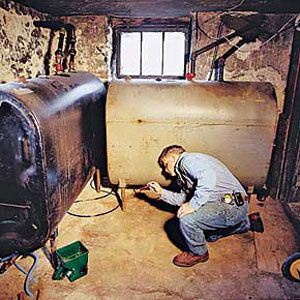
Tom Silva carries a flashlight into the attic of the three-story house, but he doesn’t need it. Daylight streams in through several coin-size holes in the roof, and the rays of sunlight pierce the musty space like in an old-master painting. “Looks like it’s been leaking for a while,” says the This Old House general contractor, as he points out dark water stains on the sheathing. A tattered trash bag dangling from a rafter is all that remains of an earlier fifty-cent solution.
Back in 1916, when the family of Christine Flynn and her niece Liz Bagely bought the up-and-down two-family the women now share, there was no house inspector to look over the property. Didn’t need it; they were the first owners. But that was a long time ago, and since then, this place has missed more than a few checkups and a lot of preventive medicine. The crew is getting ready for the start of construction by doing an informal version of what a professional inspector does when a property changes hands. But had someone been giving the house this kind of attention on a regular basis, many of its current problems could have been kept at bay.
Since inspectors always seem to find something wrong, it stands to reason that any homeowner who uses their kind of thorough thinking as a model during a once-a-year maintenance review—preferably in the fall, before rough weather sets in, and with a notepad in hand—will catch small problems before they balloon into major expenses. You don’t need to hire a pro, though it may be warranted under certain circumstances. But just knowing where and how to look will help you create a didn’t-miss-a-thing repair list, from which you can check items off one by one to keep your house in good health. “You won’t be able to do everything a pro inspector does,” says Tom, “but you’ll stay one step ahead of the wind and the rain.”
Here’s a five-step plan of attack for looking at your house with the careful eye of a pro.
1. JUDGE A BOOK BY ITS COVER
The logical place to start any fall maintenance inspection and repair list is outside, where you can take in the big picture. For Tom Silva, that means doing something as simple as standing and looking at the house. Conspicuous changes from year to year, like cockeyed windows or a sway in the roof, indicate an ongoing problem, such as a compromised foundation that’s pulling the house down.
But you also need to look at the parts that make up the whole: chimney, roofing, flashing, siding. Take note if anything is broken, cracked, curled, split, or crooked. But also pay attention to less overt signs: stains on siding that could mean water isn’t flowing through the gutters and downspouts, peeling paint or missing mortar in distressed spots, small holes or droppings near animal or insect nests. Be especially conscious of the presence of vermin, because they chew on framing and wiring.
Don’t just look at the house; look around it, too. Trees hanging over a roof aren’t just a storm threat, they may scrape roofing, give animals an access bridge, or lean dangerously close to power lines. Overgrown foliage might be more than an eyesore if it masks foundation and sill problems and contributes to siding damage. Roger Cook, TOH landscape contractor, says, “You should be able to walk between the plants and the house, even if just to have access for maintenance.” Also, be sure the ground slopes away from the house and sits at least 8 inches below the sill.
Note cracks in walkways and driveways before cold weather and frozen ground open them up and exacerbate the tripping hazard. Give fences, gates, and stone walls a little nudge to see which parts are vulnerable to tumbling in the next big storm, and take note if retaining walls are bulging or failing.
2. COME IN FOR A CLOSER LOOK
Once you’ve taken in the general state of affairs, you should examine trouble spots with a keener eye. Think about the places where water has been, or could be, coming into the house and reaching the structure. Contractors and inspectors alike repeat this mantra: Water is the biggest enemy of a house. [Article continued beneath video]

The possibilities are limitless, but doors and windows are obvious places to start, says Joe Corsetto, the president of the American Society of Home Inspectors (ASHI) and the owner of Shelterworks, an inspection firm in New Jersey. These will always take the brunt of abuse from rain and snow. Look at sills and thresholds for cracks. Make sure caulking, weatherstripping, and glazing haven’t split or worn away.
Check all framing supports—sills, posts, headers—for signs of deterioration caused by insects or rot. Probe wood with a screwdriver, looking for soft, flaking, crumbling, or damp spots. Keep an eye out for the mud tunnels made by termites or the neat holes drilled by carpenter bees. And make sure all supports are still actually connected—to the parts they hold up and to the footing or framing underneath. Be especially aware if the foundation has new or expanding fissures. “A crack that changes or grows over the seasons is a sign of instability and should be looked at by a foundation expert,” says Tom.
Your house’s skin is also vulnerable, so you need to look closely at siding and roofing for signs of failure. Stains or cracks on siding could mean water is running down the face and getting into walls. Use binoculars to look at the roof up close—is the flashing rusted, curled, or missing? Are there cracks, missing shingles, crumbling pieces? Check asphalt for dry, blistering, or curling shingles; wood for rot and splits; slate and tile for breaks; flat roofs for holes. Tom recommends going to the attic on a sunny day and turning off the lights. If you see daylight, water has a place to get in.
But you don’t always need the sun to spot the problems. Next time there’s a heavy rain, watch the water as it pools around your house. You’ll soon spot any big issues, such as how water gets into your basement or whether or not your sump pump turns on when it should.

3. GET THE INSIDE SCOOP
Sometimes you only discover structural issues by looking inside the house. Sagging floors, walls, and ceilings are obvious clues to leaks and rot. But seemingly innocuous problems, like peeling paint, sticking doors, loose floorboards, and popped drywall screws can also be signs of trouble.
Then again, sometimes a sticking door is just a nuisance. But put it on your fix-it list anyway—farther down, right next to jiggling hinges and doorknobs, loose balusters and newel posts, squeaky stairs, and scraping drawers. Now is also the time to look at ceiling fans for signs that they’ve worked their way loose. Listen to vent fans for unusual sounds that signal worn bearings in the motor.
Be sure to look beyond the easy-to-reach areas. Take a flashlight into crawl spaces and corners, inside cabinets, and up in the attic. That’s where you’ll see telltale droppings from mice or other animals. While you’re in the neighborhood, make sure joists and rafters are sound and insulation is dry. You also need to look for critters in the fireplace chimney—squeeze yourself in there and point a flashlight up the flue—and make sure to schedule the chimney sweep before the start of her busy season.
4. LET THE WATER RUN
Remember that weather isn’t the only source of water damage. A house’s own plumbing will wreak havoc if it fails. Look for signs of leaks in exposed pipes, or where they enter walls or foundations. Examine everything for rust, pits, and excessive green patina on brass or copper fittings, which signals the start of corrosion.
Look at fixtures for cracks that drip. TOH plumbing and heating expert Richard Trethewey points out that a rocking toilet or radiator could mean that a leak has compromised the floor. Likewise, a loose shower tile—or one that sounds hollow when tapped—can be covering up rotted backer board. And dishwasher and washing-machine hoses are vulnerable points if they get brittle or aren’t connected properly.
Now is the time to put those little nagging problems on your plumbing repair list as well. Dripping faucets and handles that you have to tighten more need new washers. Low water pressure may mean sediment has built up in faucet aerators and showerheads. Fill sinks and let the water out all at once to test for slow drains, which might indicate a clog or a blocked vent pipe. And you may not even know that your toilet runs until you stop and listen for a few minutes to see if it kicks in to refill.
5. ALL SYSTEMS GO
If you haven’t already done it, schedule your annual furnace maintenance—long before the first cold day. But you can be proactive by changing filters on schedule and keeping an eye out for leaks around the furnace or water tank.
One of the most overlooked hazards in a house is the electrical system, so take note of loose outlet covers and receptacle boxes, which might fray wiring. Look for scorch marks in the breaker box and around plugs, a sign of dangerous arcing. Plug a lamp into GFCI receptacles and push their test and reset buttons to see if the light goes off and on. Then put fresh batteries in all the smoke and carbon monoxide detectors.
In the end, all this careful examination may leave you with a long repair list—and a roster of pros to call. But better that they come to take care of the little things before the problems become more costly and dangerous. “When you get right down to it, inspecting your house is an ounce of prevention,” says Tom. “Trouble is, sometimes by the time I get the call, it takes a pound of cure.”
Getting Professional Help
Professional home inspections aren’t just for buyers. As house systems become more complicated, homeowners are turning to inspectors for ongoing advice. ASHI president Joe Corsetto says it can’t hurt to get an inspection every five years, or before tackling major renovations: “The inspector will analyze all the systems and help prioritize repairs. That way you’re getting a complete and unbiased picture from someone who’s not trying to sell you anything.”
Not all states license home inspectors, and standards vary widely. A safe bet is locating an inspector certified by ASHI. Expect to pay anywhere from $350 to $850, depending on where you live and the size of the house. Corsetto says a thorough inspection should take two or more hours and result in a written report, preferably with digital photos. The inspector should go anywhere a human can fit, including out-of-the-way crawl spaces. Besides a good flashlight, he should carry a moisture meter (to assess wood rot), an amp probe, long-handled mirrors, and a combustible gas detector to catch dangerous leaks.
Bonus Checklist
Click for a free Item-by-item inspection checklist, telling you places to look, sounds to listen for, and tests to run when getting your house ready for its annual maintenance.
